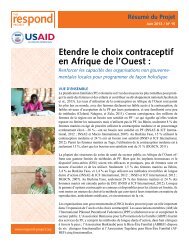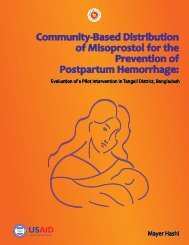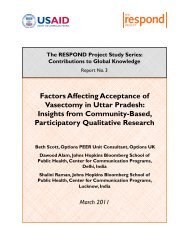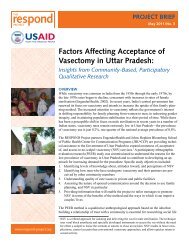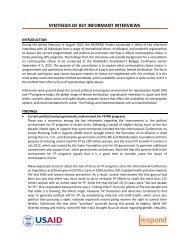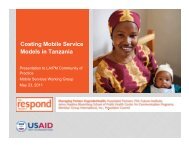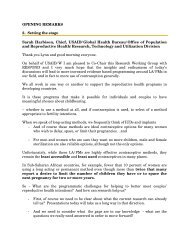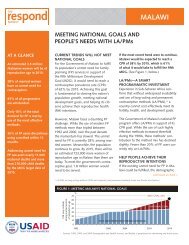synthesis of female sterilization literature review - the RESPOND ...
synthesis of female sterilization literature review - the RESPOND ...
synthesis of female sterilization literature review - the RESPOND ...
You also want an ePaper? Increase the reach of your titles
YUMPU automatically turns print PDFs into web optimized ePapers that Google loves.
SYNTHESIS OF FEMALE STERILIZATION LITERATURE REVIEW<br />
INTRODUCTION<br />
The last major <strong>review</strong> <strong>of</strong> trends in contraceptive <strong>sterilization</strong> was conducted a decade ago<br />
(EngenderHealth, 2002, pp. 85–104). Since <strong>the</strong>n, <strong>the</strong>re have been major shifts in <strong>the</strong> environment for<br />
family planning programs worldwide, most notably <strong>the</strong> shift in international donor funding and emphasis<br />
toward public health threats such as HIV and AIDS. There are also significant barriers to ensuring access to<br />
voluntary, quality <strong>sterilization</strong> services, particularly because <strong>the</strong>y require a well‐functioning clinical service<br />
delivery system. Challenges include weakened health systems and inadequate human capacity to support<br />
<strong>the</strong> routine delivery <strong>of</strong> clinical family planning methods and services; normative and gender barriers that<br />
impede family planning access and decision making; sociocultural and policy environments that<br />
compromise informed and voluntary choice (e.g., stigma toward HIV‐positive individuals, performancebased<br />
financing <strong>of</strong> family planning programs); and persistent misconceptions and misapprehensions about<br />
<strong>sterilization</strong>. Moreover, incorrect information about <strong>the</strong> method and about both past and recent reports <strong>of</strong><br />
coerced or involuntary <strong>sterilization</strong> contribute to a negative image <strong>of</strong> <strong>the</strong> method that constitutes a barrier<br />
to both access and use.<br />
In preparation for <strong>the</strong> consultation “A Fine Balance: Contraceptive Choice in <strong>the</strong> 21st Century,” to be held<br />
in Bellagio on September 4–7, 2012, <strong>the</strong> <strong>RESPOND</strong> Project conducted an electronic <strong>literature</strong> search to<br />
<strong>review</strong> research from <strong>the</strong> last 10 years on a range <strong>of</strong> topics related to how women experience <strong>female</strong><br />
<strong>sterilization</strong>.<br />
SCOPE AND METHODOLOGY<br />
The search was conducted from March to May 2012. It used <strong>the</strong> PubMed/MEDLINE and POPLINE<br />
databases, as well as general Internet searches <strong>of</strong> relevant organizations and libraries.<br />
The <strong>review</strong> consisted <strong>of</strong> two rounds <strong>of</strong> information collection. The first round, completed in March 2012,<br />
identified 114 articles, mostly published between 2001 and 2012 (100 <strong>of</strong> <strong>the</strong> 114).<br />
The search terms used in <strong>the</strong> PubMed/MEDLINE were:<br />
Main MeSH<br />
Sterilization, Tubal OR<br />
Sterilization, Reproductive<br />
Modifying MeSH<br />
+ Female<br />
Patient Satisfaction<br />
Attitude<br />
Health Knowledge, Attitudes, Practices<br />
Attitude to Health<br />
Factors<br />
Decision‐making
The search using POPLINE included <strong>the</strong> additional search terms “Tubal Ligation” and “Female Sterilization.”<br />
The supplemental internet search included Knowledge4Health (K4Health), Ipas, <strong>the</strong> U. S. Agency for<br />
International Development (USAID) Development Experience Clearinghouse (DEC), <strong>the</strong> World Health<br />
Organization (WHO), <strong>the</strong> Demographic and Health Surveys (DHS), and <strong>the</strong> Cochrane Library, to identify<br />
additional <strong>literature</strong> on factors associated with <strong>the</strong> choice <strong>of</strong> <strong>female</strong> <strong>sterilization</strong> as a method <strong>of</strong> family<br />
planning (covering medical barriers, cost, side effects, regret, religious attitudes, laws, and coercion).<br />
The second round <strong>of</strong> <strong>the</strong> search, performed in May 2012, was a more concentrated effort that focused on<br />
<strong>the</strong> following:<br />
1. General coverage <strong>of</strong> forced <strong>female</strong> <strong>sterilization</strong>, including Against Her Will: Forced and Coerced<br />
Sterilization <strong>of</strong> Women Worldwide (Open Society Foundations, 2011) and o<strong>the</strong>r internet searches<br />
2. PubMed/MEDLINE search using <strong>the</strong> terms “Sterilization, Involuntary” + “Female” and “Sterilization” +<br />
“Coercion”<br />
3. An expanded search on PubMed/MEDLINE using additional modifying terms <strong>of</strong> “Incidence,”<br />
“Prevalence,” “Emotions,” and “/statistics & numerical data”<br />
This second round contributed an additional 155 references, including a new subset <strong>of</strong> articles on coercion.<br />
After <strong>the</strong> elimination <strong>of</strong> duplicate sources and articles that were not relevant to this <strong>review</strong>, 79 articles<br />
remained and were used in this <strong>review</strong>.<br />
Many <strong>of</strong> <strong>the</strong>se reports <strong>of</strong> coerced <strong>sterilization</strong>s are also documented at Stop Torture in Health Care<br />
(www.stoptortureinhealthcare.org/forced‐<strong>sterilization</strong>).. There are several short videos (also available on<br />
youtube.com) <strong>of</strong> cases <strong>of</strong> women from a variety <strong>of</strong> countries (e.g., “They Took My Choice Away” and “The<br />
Secret That Kills My Heart”) and recent news stories <strong>of</strong> forced <strong>sterilization</strong>s.<br />
Based on <strong>the</strong> earliest reference from our search (McGarrah, 1974) and including references from <strong>the</strong> late<br />
1990s (Bakamjian, 1997; FHI, 1997) and recent guidelines issued post‐2005 (ACOG, 2007; FIGO, 2011;<br />
IFHHRO, 2011), <strong>female</strong> <strong>sterilization</strong> is widely used and safe—but may be open to abuse.<br />
The <strong>literature</strong> <strong>review</strong>ed has been organized into five categories: client characteristics, reasons for choosing<br />
<strong>female</strong> <strong>sterilization</strong>, coercion, barriers, and regret. Key findings are summarized below.<br />
CLIENT CHARACTERISTICS<br />
The characteristics <strong>of</strong> women who become sterilized fall into general groupings along regional lines.<br />
Women in Asia (and in Brazil) tend to have <strong>the</strong> lowest parity and age at <strong>sterilization</strong> (2–3 children, age in<br />
<strong>the</strong> mid‐to‐late 20s), followed by women in Latin America, North America, and Europe (three children,<br />
aged 30–35); women in Africa have <strong>the</strong> highest parity and age at <strong>the</strong> time <strong>of</strong> <strong>sterilization</strong> (approximately 5–<br />
6 children, ages 35–40) (Gilliam et al., 2008; Brown et al., 2007; Ruminjo & Lynam,, 1997; Vieira & Ford,<br />
2004; Mansour, 2007; Mutihir & Nyango, 2011; Bhasin & Nag, 2007). Characteristics common to <strong>the</strong>se<br />
women across <strong>the</strong> globe are rural residence, low educational levels, and low socioeconomic status (Baveja<br />
et al., 2000; Arora et al., 2010; Mannan, 2002; ATP, 2010; Tobar et al., 2009). It seems that poor education<br />
and low socioeconomic status precede early childbearing, and <strong>the</strong> subsequent financial difficulties in<br />
caring for additional children drive a desire to limit fertility. However, it is unclear to what extent <strong>the</strong><br />
accessibility and availability <strong>of</strong> <strong>sterilization</strong> relative to o<strong>the</strong>r contraceptive methods affects <strong>the</strong> choice <strong>of</strong><br />
<strong>sterilization</strong> over those methods. In <strong>the</strong> published <strong>literature</strong>,<strong>the</strong> majority <strong>of</strong> women who undergo<br />
<strong>sterilization</strong> are married, and most have ei<strong>the</strong>r private or public insurance (Baldwin et al., 2012; Swende &<br />
Hwande, 2010; Bumpass et al., 2000; Mannan, 2002; Vieira & Ford, 2004). Finally, in three studies<br />
reporting on <strong>the</strong> topic, exposure to mass media was associated with <strong>sterilization</strong> in two and had a very low<br />
2 | Syn<strong>the</strong>sis <strong>of</strong> Female Sterilization Literature Review
level <strong>of</strong> effect in one (Stephenson, 2006; Thind, 2005; WHO, 2003). In <strong>the</strong> first survey (Stephenson, 2006),<br />
<strong>the</strong> level <strong>of</strong> exposure is not given, and in <strong>the</strong> second (Thind, 2005), only 32% <strong>of</strong> respondents had received<br />
any family planning messages from mass media.<br />
REASONS FOR CHOOSING FEMALE STERILIZATION<br />
Women give numerous reasons for <strong>the</strong>ir decision to become sterilized. The most common reasons are not<br />
surprising: The woman has reached her desired parity, and <strong>the</strong> procedure is permanent (Mannan, 2002[<br />
Kane et al., 2009). O<strong>the</strong>r reasons include: <strong>the</strong> perception that <strong>sterilization</strong> is more reliable/effective; fear <strong>of</strong><br />
o<strong>the</strong>r methods; greatest familiarity with <strong>sterilization</strong> among all available methods; and <strong>the</strong> fact that it does<br />
not involve <strong>the</strong> taking <strong>of</strong> hormones (Bhasin & Nag, 2007; Cremer et al., 2008; Kane et al., 2009). The latter<br />
is especially important to women who are breastfeeding postpartum and those who have been unhappy<br />
with <strong>the</strong> side effects <strong>of</strong> hormonal contraceptives in <strong>the</strong> past (Vieira, 1999; Vieira & Ford, 2004). Finally, an<br />
anthropological study conducted in rural south India <strong>the</strong>orized that <strong>sterilization</strong> rates were high among<br />
young women because <strong>the</strong>y used <strong>the</strong> procedure to gain a measure <strong>of</strong> autonomy within <strong>the</strong> family: A<br />
woman who reaches <strong>the</strong> end <strong>of</strong> her reproductive years becomes <strong>the</strong> prestigious “matriarch” <strong>of</strong> <strong>the</strong> family,<br />
thus reducing <strong>the</strong> mo<strong>the</strong>r‐in‐law’s claim to reign over <strong>the</strong> family and marginalizing her as a respected, but<br />
less influential, elder (Saavala, 1999).<br />
Despite <strong>the</strong> reasons given by women for choosing to become sterilized, <strong>the</strong> categorization <strong>of</strong> “choice” is<br />
complicated by issues <strong>of</strong> exceeding desired parity, poor information about <strong>the</strong> procedure and about<br />
possible complications, and lack <strong>of</strong> access to o<strong>the</strong>r methods. Although regret after <strong>the</strong> procedure appears<br />
to be low across countries among those aged 30 and older and those married for longer periods (Lawrence<br />
et al., 2011; Mansour, 2007; TAHSEEN Project/CATALYST Consortium, 2005), <strong>the</strong> ability to freely choose to<br />
become sterilized at <strong>the</strong> level <strong>of</strong> desired parity is somewhat <strong>of</strong> concern, because <strong>of</strong> reported cases <strong>of</strong><br />
women not receiving <strong>sterilization</strong> at <strong>the</strong>ir first request and subsequently becoming pregnant (Potter et al.,<br />
2003; Zite et al., 2006; Gilliam et al., 2008; Thurman et al., 2010; Vieira & Souza, 2009). In addition, choice<br />
involves <strong>the</strong> issue <strong>of</strong> informed choice, which can be difficult to discern. In a recent article on reasons given<br />
by young women in rural India for adopting <strong>sterilization</strong>, <strong>the</strong> author stated that 35% <strong>of</strong> <strong>the</strong> respondents<br />
were unaware <strong>of</strong> any method <strong>of</strong> temporary contraception and 94% were unaware that <strong>the</strong>re could be any<br />
complications from <strong>the</strong> procedure (Arora et al., 2010). Correspondingly, a 2008 sample <strong>of</strong> 1,500 women in<br />
<strong>the</strong> U.S. state <strong>of</strong> Texas showed being able to successfully obtain <strong>sterilization</strong> was associated with making<br />
antenatal care visits, which implies that women who do not have access to antenatal care (or are not<br />
currently pregnant) are less able to make an informed choice about <strong>sterilization</strong> or to have <strong>the</strong> ability to<br />
access <strong>the</strong> procedure (Thurman et al., 2009).<br />
Because <strong>of</strong> lack <strong>of</strong> access to o<strong>the</strong>r methods and to <strong>sterilization</strong> not <strong>of</strong>fered in <strong>the</strong> context <strong>of</strong> cesarean<br />
section, <strong>the</strong> choice that a woman makes may actually be <strong>the</strong> only one available to her. For many women,<br />
<strong>sterilization</strong> may be <strong>the</strong> only option (or <strong>the</strong> only long‐term option) that is available in her area or is<br />
presented by her health care provider. For o<strong>the</strong>rs, less invasive <strong>sterilization</strong> techniques that some women<br />
might find preferable, such as minilaparotomy or nonsurgical <strong>sterilization</strong> (e.g., Essure, Adiana), are not<br />
available (Stephenson, 2006; Cremer et al., 2008; Osis et al., 2003; Ruminjo & Lyman, 2007; WHO, 2003;<br />
ATP, 2010; Mutihir & Nyango, 2011). A 15‐year study <strong>of</strong> <strong>female</strong> <strong>sterilization</strong> in Kenya showed that 72% <strong>of</strong><br />
women who were sterilized had never used ano<strong>the</strong>r form <strong>of</strong> contraception (Ruminjo & Lyman, 1997),<br />
while a WHO study put <strong>the</strong> estimate <strong>of</strong> those who were sterilized without previous contraceptive use at<br />
84% (WHO, 2003). This indicates ei<strong>the</strong>r that o<strong>the</strong>r contraceptive options are not available or that <strong>the</strong>se<br />
women are encouraged to have <strong>the</strong> expected number <strong>of</strong> children and <strong>the</strong>n terminate fertility with a<br />
permanent method.<br />
3 | Syn<strong>the</strong>sis <strong>of</strong> Female Sterilization Literature Review
Fur<strong>the</strong>r, a significant amount <strong>of</strong> research, particularly from Brazil, has documented what could be termed<br />
unnecessarily high rates <strong>of</strong> cesarean section under conditions where women cannot obtain <strong>sterilization</strong><br />
unless it is combined with childbirth. This may be due to insurance regulations, provider reimbursement,<br />
cost, or <strong>the</strong> need to frame <strong>the</strong> procedure as one that is done for medical ra<strong>the</strong>r than contraceptive<br />
purposes (Shinkman, 2008; Thurman et al., 2010; Vieira & Ford, 2004; Carvalho et al., 2007). Statistics for<br />
<strong>the</strong> percentage <strong>of</strong> <strong>female</strong> <strong>sterilization</strong> procedures that are done in combination with a cesarean delivery<br />
range from about 50–75% (Baldwin et al., 2012; de Bessa, 2006; Baveja et al., 2000), while o<strong>the</strong>r studies<br />
show a lower rate <strong>of</strong> independent <strong>sterilization</strong> (not in combination with cesarean section) when women<br />
are denied coverage or face rising copayments and costs for <strong>the</strong> independent procedure (Rodriguez et al.,<br />
2008; Chapa & Venegas, 2012; Bakken et al., 2007). Although it is likely that some proportion <strong>of</strong> <strong>the</strong>se<br />
women would ra<strong>the</strong>r be sterilized in combination with cesarean section because it is simple to do in<br />
combination, undoubtedly many women are being forced into doing so unnecessarily. Finally, <strong>the</strong> choice<br />
to undergo <strong>female</strong> <strong>sterilization</strong> may be partially directed by <strong>the</strong> refusal <strong>of</strong> male partners to undergo<br />
<strong>sterilization</strong> <strong>the</strong>mselves. Although this can vary by country, a recent study in Turkey reported that 96% <strong>of</strong><br />
husbands refuse to consider a vasectomy (Gunenc et al., 2009). Thus, <strong>the</strong> onus for fertility regulation can<br />
be unfairly placed on women, when <strong>the</strong>ir preferred choice might have been for <strong>the</strong>ir partner to have a<br />
simpler and less costly vasectomy.<br />
COERCION<br />
The legacy <strong>of</strong> forced and coerced <strong>sterilization</strong>s mars <strong>the</strong> history <strong>of</strong> many family planning programs in both<br />
developed and developing countries. The role <strong>of</strong> eugenics in different countries varied in <strong>the</strong> degree <strong>of</strong> its<br />
integration into national policy and <strong>the</strong> intensity <strong>of</strong> its implementation, with extreme examples occurring<br />
during World War II. One common factor in most countries is <strong>the</strong> disparate focus many <strong>of</strong> <strong>the</strong>se policies<br />
had on minority or o<strong>the</strong>r disadvantaged subsets <strong>of</strong> <strong>the</strong> population. Most countries have since changed<br />
<strong>the</strong>se policies and have at least <strong>the</strong>oretically specified programs that focus on voluntary <strong>sterilization</strong>.<br />
However, <strong>the</strong> extent to which coercive activities continue to exist in specific countries is <strong>the</strong> subject <strong>of</strong><br />
many articles and reports, in both <strong>the</strong> formal and informal <strong>literature</strong> (such as peer‐<strong>review</strong>ed journals and<br />
program reports) and through reporting <strong>of</strong> stories by international news organizations.<br />
Current discourse on <strong>sterilization</strong> coercion focuses on two main topics: continued quests for restitution for<br />
victims <strong>of</strong> past wrongs, and current cases <strong>of</strong> coercion that continue to affect minority subsets <strong>of</strong><br />
populations. The legacy <strong>of</strong> past policies lives on in <strong>the</strong> vigilance <strong>of</strong> human rights organizations to secure<br />
restitution for surviving victims and <strong>the</strong> insistence that <strong>the</strong> last remnants <strong>of</strong> <strong>the</strong>se programs, both formal<br />
and informal, be completely eliminated. This has led to <strong>the</strong> continued production and publication <strong>of</strong> policy<br />
statements by international organizations and consortiums that call for <strong>the</strong> reconfirmation <strong>of</strong> informed<br />
consent for all <strong>sterilization</strong> procedures (FIGO, 2011; IFHHRO, 2011).<br />
Recent court cases attempting to gain restitution for past instances <strong>of</strong> coerced <strong>sterilization</strong>s in <strong>the</strong> Czech<br />
Republic (Krosnar, 2006) and <strong>the</strong> United States (Schoen, 2005) continue to highlight <strong>the</strong> extent <strong>of</strong> past<br />
coercion. The U.S. cases occurred between <strong>the</strong> 1920s and <strong>the</strong> 1970s, while <strong>the</strong> Czech Republic cases<br />
occurred between 1973 and 2004. Formal policies were developed to address <strong>the</strong> U.S.‐based cases, while<br />
human rights organizations continue to pressure <strong>the</strong> Czech government to accept responsibility for 50<br />
identified cases <strong>of</strong> coerced <strong>sterilization</strong>. There is also a single case from Slovakia that is pending a decision<br />
from <strong>the</strong> European Court <strong>of</strong> Human Rights; it involves an incident in which inaccurate medical information<br />
was provided to force consent (Zampas & Lamackova, 2011). The case previously went through <strong>the</strong><br />
Slovakian legal system and resulted in a court ruling on <strong>the</strong> side <strong>of</strong> <strong>the</strong> medical provider.<br />
4 | Syn<strong>the</strong>sis <strong>of</strong> Female Sterilization Literature Review
Documented current cases <strong>of</strong> coercion are geographically concentrated in Eastern Europe, Central Asia,<br />
and Sou<strong>the</strong>rn Africa. In Eastern Europe and Central Asia, <strong>the</strong> majority <strong>of</strong> current cases involve coercion <strong>of</strong><br />
Roma/Gypsy populations.<br />
Instances in Slovakia, <strong>the</strong> Czech Republic, and Uzbekistan have been identified by international and<br />
national organizations. In Slovakia, a 2002 survey by <strong>the</strong> Center for Reproductive Rights found that 140 out<br />
<strong>of</strong> 230 Gypsy women whom <strong>the</strong>y interviewed had been coerced into being sterilized (Center for<br />
Reproductive Rights, 2003). The report did not contain an exact timeframe for <strong>the</strong> <strong>sterilization</strong>s but<br />
identified <strong>the</strong>m all as having occurred in <strong>the</strong> post‐Communist period (when eugenic policies were <strong>of</strong>ficially<br />
ended). The report details instances <strong>of</strong> <strong>sterilization</strong> being coerced both overtly and secretly. The overt<br />
episodes <strong>of</strong> coercion included instances <strong>of</strong> intimidation where Gypsy women ei<strong>the</strong>r were told that <strong>the</strong>y<br />
had to get sterilized or were berated into signing a consent form by a medical provider. Ano<strong>the</strong>r form <strong>of</strong><br />
overt coercion documented in <strong>the</strong> report is through <strong>the</strong> provider’s giving <strong>the</strong> women misleading, incorrect,<br />
or incomplete medical information, such as saying that she or her child will die if she has ano<strong>the</strong>r<br />
pregnancy. The cases <strong>of</strong> hidden or secret coercion for <strong>sterilization</strong> were all performed during cesarean<br />
deliveries, when <strong>the</strong> women ei<strong>the</strong>r did not give her consent at all or was asked to sign a consent form<br />
while partially under anes<strong>the</strong>sia, <strong>the</strong>refore negating <strong>the</strong> ability to give informed consent (Zampas &<br />
Lamackova, 2011).<br />
In Uzbekistan, examples <strong>of</strong> coerced <strong>sterilization</strong> were recently reported by <strong>the</strong> British Broadcasting<br />
Company (BBC) (BBC Online, 2012). The report used <strong>of</strong>f‐<strong>the</strong>‐record interviews with alleged victims and<br />
Ministry <strong>of</strong> Health personnel, including providers, to document stories <strong>of</strong> coercion. The information<br />
included in <strong>the</strong> article is anecdotal, since it does not provide explicitly stated sources and documented<br />
instances, but <strong>the</strong> picture that <strong>the</strong> article provides is one in which Roma women were being overtly<br />
pressured into getting sterilized through intimidation and <strong>the</strong> distribution <strong>of</strong> inaccurate medical<br />
information. The report also highlights many instances <strong>of</strong> clandestine <strong>sterilization</strong> <strong>of</strong> women during<br />
cesarean deliveries. These women did not find out that <strong>the</strong>y had been sterilized until <strong>the</strong>y returned to <strong>the</strong><br />
clinic at a later period and were informed that <strong>the</strong>y could no longer get pregnant. The intent <strong>of</strong> <strong>the</strong> article<br />
was to imply that <strong>the</strong>se practices were widespread and not only were sanctioned by <strong>the</strong> government, but<br />
were actively encouraged.<br />
Coerced <strong>sterilization</strong> <strong>of</strong> HIV‐positive women in Namibia is well‐documented. The exact number <strong>of</strong> cases is<br />
unknown, and various articles give different numbers <strong>of</strong> women. Examples include women being forced to<br />
sign consent forms as a prerequisite for maternity care (Gatsi et al., 2010), consent being given based on<br />
inaccurate or incomplete medical information, and women being forced to sign forms without an<br />
explanation <strong>of</strong> <strong>the</strong> contents (Gatsi et al., 2010, Mallet & Kalambi, 2008). It is reported that <strong>the</strong> problem is<br />
widespread and currently identified victims are a drastic underestimate <strong>of</strong> <strong>the</strong> total number <strong>of</strong> women<br />
affected. A 2009 story in The Globe and Mail gave additional examples <strong>of</strong> coercive <strong>sterilization</strong> and<br />
discussed <strong>the</strong> role that cultural norms related to power dynamics between clinician and patient play in<br />
forcing women to give consent. A woman interviewed stated that when dealing with a health care<br />
provider, “<strong>the</strong>y tell you to do something and you do it,” regardless <strong>of</strong> what it is (York, 2009). A 2011<br />
Kenyan newspaper article features stories <strong>of</strong> several HIV‐positive women who were coercively sterilized<br />
(Oyugi, 2011).<br />
O<strong>the</strong>r women who are at risk <strong>of</strong> coerced <strong>sterilization</strong> are <strong>the</strong> disabled. Documentation concerning this<br />
category <strong>of</strong> women is mainly from developed countries, such as Australia (Brady, 2001), Belgium (Servais<br />
et al., 2004), and Taiwan (Chou & Lu, 2011), and <strong>the</strong>refore information on this issue is not presented here.<br />
5 | Syn<strong>the</strong>sis <strong>of</strong> Female Sterilization Literature Review
BARRIERS<br />
There are numerous barriers identified in <strong>the</strong> <strong>literature</strong> on <strong>sterilization</strong> that can impede <strong>the</strong> provision and<br />
uptake <strong>of</strong> <strong>sterilization</strong> services. These include: legal requirements, user fees and insurance mandates,<br />
providers’ attitudes, poor access to and/or availability <strong>of</strong> services, and religious or cultural censorship.<br />
Although <strong>the</strong> majority <strong>of</strong> what is written regarding <strong>the</strong>se barriers to <strong>sterilization</strong> is anecdotal and for time<br />
periods in <strong>the</strong> past that are not likely reflective <strong>of</strong> <strong>the</strong> present, <strong>the</strong> small number <strong>of</strong> available studies that<br />
are rigorous and recent show a fairly consistent picture <strong>of</strong> <strong>the</strong>se barriers posing a serious obstacle to<br />
<strong>sterilization</strong>. This picture does change depending upon <strong>the</strong> country context, but even in countries<br />
advanced in family planning, one or more <strong>of</strong> <strong>the</strong>se barriers are evident.<br />
Legal and policy constraints<br />
Legal constraints to <strong>sterilization</strong> can vary across countries, and <strong>the</strong>re are few comprehensive sources that<br />
give actual policy requirements by country in terms <strong>of</strong> parity, age, consent, waiting period after requesting<br />
<strong>sterilization</strong>, citizenship, and identification. This opacity in laws and policy is also found at <strong>the</strong> national level<br />
and contributes to poor information among both providers and potential users as to what is permissible<br />
(ATP, 2010). In a 10‐year‐old summary from EngenderHealth that draws information from program<br />
reporting from 137 countries, it was reported that <strong>sterilization</strong> for contraceptive purposes was permissible,<br />
in 74 countries although <strong>of</strong> <strong>the</strong>se, in some cases it was predominantly legal opinion and not explicit law that<br />
formed <strong>the</strong> basis <strong>of</strong> <strong>the</strong> categorization. In 55 o<strong>the</strong>r countries, <strong>the</strong> law was unclear or <strong>the</strong>re were conflicting<br />
policies, and in eight countries <strong>sterilization</strong> was forbidden except for medical or eugenic reasons. The report<br />
also stated that 25 countries had consent requirements for persons in addition to <strong>the</strong> woman requesting<br />
<strong>the</strong> <strong>sterilization</strong>, and 24 countries had age or parity requirements (EngenderHealth, 2002).<br />
Of <strong>the</strong> legal policies that are in <strong>the</strong> published, peer‐<strong>review</strong>ed <strong>literature</strong>, <strong>the</strong>re is <strong>the</strong> same reiteration in this<br />
range <strong>of</strong> legal barriers. On one end are countries such as Argentina, where <strong>the</strong> penal code imposes<br />
punishment <strong>of</strong> imprisonment for a minimum <strong>of</strong> three years and up to 15 years for inflicting <strong>the</strong> loss <strong>of</strong><br />
capacity to conceive or procreate. Brazil is well‐documented as requiring a minimum age <strong>of</strong> 25, parity <strong>of</strong> at<br />
least two children, spousal consent, and a signed recommendation from two physicians before <strong>sterilization</strong><br />
can be performed (Cook & Dickens, 2000; Osis et al., 2003). Similarly, Hungary has multiple restrictions on<br />
age and parity that include needing to be age 40 or older if <strong>the</strong> woman is nulliparous, 35 or older if she has<br />
three or more children, or 30 or older if she has four or more children (ASTRA, 2006). O<strong>the</strong>r countries, such<br />
as <strong>the</strong> United States and Germany, have few requirements, but even a liberal national policy can be<br />
complicated by cumbersome paperwork and provider reimbursement rates <strong>of</strong> insurance providers (Zite et<br />
al., 2006; Gilliam et al., 2008), by religious directives that prohibit <strong>sterilization</strong> in faith‐based institutions<br />
(Bassett, 2001; Galloro, 2000; Tieman, 2002), and state‐level bureaucracies that set alternate restrictions<br />
based on budgetary constraints and political tides in areas such as <strong>the</strong> health care for noncitizens. For<br />
example, in 2004, <strong>the</strong> U.S. state <strong>of</strong> Oregon rescinded a policy in which those who were insured through<br />
emergency Medicaid could receive an elective <strong>sterilization</strong> postpartum. Tubal ligation among those<br />
patients <strong>the</strong>n dropped from 10% to 1%, and women covered by emergency medical insurance who<br />
wanted to be sterilized could only do so during a cesarean section (Rodriguez et al., 2008; Baldwin et al.,<br />
2012). The same pattern <strong>of</strong> women’s needing to shift to cesarean deliveries to obtain tubal ligation is<br />
observed in countries that raised <strong>the</strong> copayment charges or decreased provider reimbursement rates for<br />
“stand alone” <strong>sterilization</strong> (Bakken et al., 2007; Mansour, 2007; TAHSEEN Project/CATALYST Consortium,<br />
2005; Chen et al., 2008; Thurman et al., 2009).<br />
Provider attitudes<br />
Provider attitudes that derive from <strong>the</strong> aforementioned constraints, combined with fear <strong>of</strong> recrimination<br />
from unhappy users, can serve to be a significant barrier against women who want to be sterilized (Gilliam<br />
6 | Syn<strong>the</strong>sis <strong>of</strong> Female Sterilization Literature Review
et al., 2008; Brown et al., 2007; Vieira & Souza, 2009; Chen et al., 2008; Okunlola et al., 2007). Vagueness<br />
in public policy concerning <strong>the</strong> definition <strong>of</strong> major surgery and who can perform it, for example, can thwart<br />
attempts to increase <strong>the</strong> availability <strong>of</strong> <strong>sterilization</strong> by task shifting to lower cadre workers trained in <strong>the</strong><br />
procedure (Acquire Tanzania, Wickstrom). In addition, health workers, from physicians to nurses and<br />
medical technicians, may have personal biases that can contravene national policy. In a recent study in <strong>the</strong><br />
United States on physician influence, 45% <strong>of</strong> physicians would discourage contraceptive <strong>sterilization</strong> in a<br />
woman who had had two pregnancies and one live birth, while 29% would do so for a woman with four<br />
pregnancies and three live births. Fifty‐nine percent reported that <strong>the</strong>y would discourage a 26‐year‐old<br />
woman whose husband disagreed, while 32% would discourage a 26‐year‐old whose husband agreed.<br />
Fur<strong>the</strong>r, physicians who attend religious services twice a month or more were more likely than those who<br />
did not to say <strong>the</strong>y would dissuade clients from seeking tubal ligation (Lawrence et al., 2011). However, it<br />
is important to note that empowered women who continue to request <strong>the</strong> procedure may be able to<br />
overcome provider bias, as 90% <strong>of</strong> resistant physicians in that study eventually consented to provide <strong>the</strong><br />
procedure. Also, policy changes such as India’s Family Health Insurance Act, which covers claims against<br />
physicians if <strong>sterilization</strong> is not successful, may serve to increase providers’ support for <strong>the</strong> procedure<br />
(Noopur & Sharma, 2009).<br />
Access barriers<br />
Barriers may also exist in terms <strong>of</strong> poor access to and availability <strong>of</strong> <strong>sterilization</strong> services. In rural areas,<br />
distance can be prohibitive, and <strong>the</strong> time it takes to undertake and recover from <strong>the</strong> procedure (depending<br />
on <strong>the</strong> type) can be more than families are willing to accommodate (Vieira & Souza, 2009; TAHSEEN<br />
Project/CATALYST Consortium, 2005). Even in developed countries, issues <strong>of</strong> staffing, availability <strong>of</strong><br />
operating rooms, missing paperwork, and stock‐outs <strong>of</strong> necessary equipment can prevent requested<br />
<strong>sterilization</strong>s from moving forward (ATP, 2010; Zite et al., 2006; Wickstrom & Jacobstein, 2008; Vieira &<br />
Souza, 2009). It is not clear from <strong>the</strong> limited <strong>literature</strong> how common <strong>the</strong>se issues are in affecting access to<br />
and availability <strong>of</strong> <strong>sterilization</strong> services, or which among <strong>the</strong>m should be addressed first. There is evidence<br />
suggesting that <strong>sterilization</strong> uptake increases when services are expanded: In Pakistan, <strong>the</strong> opening <strong>of</strong> new<br />
family planning clinics in urban areas contributed to a rise in <strong>female</strong> <strong>sterilization</strong> from 14% to 22% in three<br />
years (Hennink & Clements, 2005).<br />
Sociocultural barriers<br />
Finally, family pressure and societal stigma may also pose barriers due to cultural or religious norms<br />
dominant in <strong>the</strong> area in which a woman lives. Although extensive analysis has been done concerning <strong>the</strong><br />
approval <strong>of</strong> husbands and even in‐laws concerning family planning, little specific could be found in regard<br />
to <strong>sterilization</strong> o<strong>the</strong>r than personal narratives and general author observations (TAHSEEN<br />
Project/CATALYST Consortium, 2005; Nosaka & Bairagi, 2008; Kamal, 2000; WHO, 2003; Ruminjo & Lynam,<br />
1997). Although <strong>the</strong>re is not enough historical data in any one country to determine trends in <strong>sterilization</strong><br />
according to son preference, recent evidence does suggest that women in some countries are unwilling to<br />
undergo <strong>sterilization</strong> until <strong>the</strong>y have one or more sons (Mannan, 2002; Thind, 2005; Jayaraman, 2008). A<br />
newly published study using data from 2002 reports that Indian women with a specific family composition<br />
<strong>of</strong> two boys and one girl are 90% less likely to report having ano<strong>the</strong>r pregnancy and 12 times more likely to<br />
be sterilized than are women who have two daughters only (Edmeades et al., 2102). The extent to which<br />
religion plays a role as a barrier to <strong>sterilization</strong> depends upon <strong>the</strong> religion, on <strong>the</strong> interpretation <strong>of</strong> <strong>the</strong><br />
Bible and Koran by religious leaders, and on <strong>the</strong> homogeneity <strong>of</strong> <strong>the</strong> faith in a particular region (Okunlola<br />
et al., 2007; Bassett, 2001; Krehbiel Keefe, 2006). A sample <strong>of</strong> women in India showed that <strong>the</strong> prevalence<br />
<strong>of</strong> <strong>sterilization</strong> among Muslim women (14%) was lower than among Hindu women (29%) and among<br />
women from o<strong>the</strong>r religious groups (30–35%), while non‐Muslims in Bangladesh were twice as likely to<br />
undergo <strong>sterilization</strong> as were Muslims (Mannan, 2002). However, <strong>sterilization</strong> rates can still be high in<br />
7 | Syn<strong>the</strong>sis <strong>of</strong> Female Sterilization Literature Review
Catholic countries such as Brazil and in Muslim countries such as Turkey, which implies that religious<br />
guidelines are not always (whe<strong>the</strong>r by necessity or choice) strictly interpreted, implemented, or adopted.<br />
REGRET<br />
Most information on <strong>sterilization</strong> regret is from developing countries and uses data from <strong>the</strong> 1990s to as<br />
far back as <strong>the</strong> 1970s. However, <strong>the</strong> reasons for regret remain constant: being young at <strong>the</strong> time <strong>of</strong><br />
<strong>sterilization</strong>; making <strong>the</strong> decision under duress; changing family dynamics; and having had <strong>the</strong> procedure<br />
suggested by someone o<strong>the</strong>r than <strong>the</strong> patient.<br />
A systematic <strong>review</strong> <strong>of</strong> 19 articles done in 2006 using data from seven developed areas (Australia, Canada,<br />
Denmark, New Zealand, Sweden, Puerto Rico, and <strong>the</strong> United States,) and two middle‐income or lessdeveloped<br />
countries (Brazil and <strong>the</strong> Dominican Republic) found an increased relative risk <strong>of</strong> regret for<br />
women who were sterilized before age 30 (Curtis et al., 2006). Combined results from all studies showed<br />
that women who were sterilized before age 30 were twice as likely to regret <strong>the</strong> procedure as were<br />
women sterilized after 30. Additional studies done in <strong>the</strong> United States and India confirmed this<br />
relationship. In <strong>the</strong> United States, data from 1978–1987 showed an incidence <strong>of</strong> regret among women<br />
aged 20–24 <strong>of</strong> 4.3%, compared with 2.4% among women aged 30–34 at <strong>sterilization</strong>. This remained true<br />
regardless <strong>of</strong> parity or marital status (Ryder & Vaughan, 1999). Ano<strong>the</strong>r U.S. study, this one using data<br />
from a prospective study conducted in <strong>the</strong> 1980s and 1990s, found that women aged 30 and younger at<br />
<strong>sterilization</strong> had a probability <strong>of</strong> regret <strong>of</strong> 20.3%, compared with a probability <strong>of</strong> 5.9% for women older<br />
than 30 (ACOG, 2003). However, overall rates <strong>of</strong> regret were low. In India, a study in four sou<strong>the</strong>rn states<br />
found very low levels <strong>of</strong> regret (less than 10% overall), but a significant factor for regret was young age at<br />
time <strong>of</strong> <strong>sterilization</strong> (Ramanathan & Mishra, 2000). A secondary analysis <strong>of</strong> 1991 DHS data in <strong>the</strong><br />
Dominican Republic also found that age less than 30 at <strong>sterilization</strong> was a significant contributor to regret<br />
(Loaiza, 1995).<br />
Ano<strong>the</strong>r factor found to be associated with regret can be categorized as major life events. One such event<br />
is <strong>the</strong> death <strong>of</strong> a child, as seen in Brazil (Machado et al., 2005), India (Ramanathan & Mishra, 2000), and<br />
<strong>the</strong> United States (ACOG, 2003). Ano<strong>the</strong>r event is change in marital status—ei<strong>the</strong>r getting divorced or<br />
taking on a new partner. This relationship to regret was found in Brazil (Machado et al., 2005) and <strong>the</strong><br />
United States (ACOG, 2003). In addition, external pressure from a clinician was found in a U.S. study to be<br />
associated with regret (ACOG, 2003).<br />
Only one study, done in Zimbabwe among patients who were sterilized in <strong>the</strong> 1990s, compared regret from<br />
opposing perspectives. That study found that women were more likely to regret not getting sterilized than<br />
<strong>the</strong>y were to regret getting sterilized (40% compared with 2.5%). This relationship remained constant even<br />
when <strong>the</strong> decision to get sterilized was done following an emergency cesarean delivery (Verkuyl, 2002).<br />
References<br />
ACQUIRE Tanzania Project (ATP). 2010. Increasing access to family planning: The case for task‐shifting <strong>female</strong><br />
surgical contraceptive services. ATP Brief No. 1, EngenderHealth: Dar es Salaam.<br />
American College <strong>of</strong> Obstetricians and Gynecologists (ACOG). 2003. Benefits and risks <strong>of</strong> <strong>sterilization</strong> (ACOG<br />
Practice Bulletin: No 46). International Journal <strong>of</strong> Gynecology & Obstetrics 83(3):339–350.<br />
ACOG. 2007. ACOG Committee Opinion. No. 371. July 2007. Sterilization <strong>of</strong> women, including those with mental<br />
disabilities. Obstetrics and Gynecology 110(1):217–220.<br />
8 | Syn<strong>the</strong>sis <strong>of</strong> Female Sterilization Literature Review
Antelava, N.. 2012. Uzbekistan’s policy <strong>of</strong> secretly sterilizing women. British Broadcasting Company. Accessed<br />
at: www.bbc.co.uk/new/magazine‐17612550.<br />
Arora, N., S. Choudhary, et al. 2010. Young women opting for tubal sterilisation in rural India: reasons and<br />
implications. Journal <strong>of</strong> Obstetrics and Gynaecology: The Journal <strong>of</strong> <strong>the</strong> Institute <strong>of</strong> Obstetrics and Gynaecology<br />
30(2):175–178.<br />
ASTRA—Central and Eastern European Women's Network for Sexual and Reproductive Health and Right. 2006.<br />
Sterilization laws and government funding for family planning services in EU countries. Accessed at:<br />
www.astra.org.pl/<strong>sterilization</strong>.pdf.<br />
Bakamjian, L. 1997. Opinion: Voluntary Sterilization—Six Lessons Learned. Network 18(1).<br />
Bakken, I. J., F. E. Skjeldestad, et al. 2007. Strong decline in <strong>female</strong> <strong>sterilization</strong> rates in Norway after <strong>the</strong><br />
introduction <strong>of</strong> a new copayment system: a registry based study. BMC Women’s Health 7:12.<br />
Baldwin, M. K., M. I. Rodriguez, et al. 2012. Lack <strong>of</strong> insurance and parity influence choice between long‐acting<br />
reversible contraception and <strong>sterilization</strong> in women postpregnancy. Contraception 86(1):42–47.<br />
Bassett, W. W. 2001. Private religious hospitals: limitations upon autonomous moral choices in reproductive<br />
medicine. Journal <strong>of</strong> Contemporary Health Law and Policy 17(2):455–583.<br />
Baveja, R., K. Buckshee, et al. 2000. Evaluating contraceptive choice through <strong>the</strong> method‐mix approach. An<br />
Indian Council <strong>of</strong> Medical Research ICMR) task force study. Contraception 61(2): 113–119.<br />
Bhasin, M. K. and S. Nag. 2007. Demography <strong>of</strong> <strong>the</strong> tribal groups <strong>of</strong> Rajasthan: 5. Dynamics <strong>of</strong> family planning<br />
methods usage. Anthropologist 9(2):99–106.<br />
Brady, S. M. 2001. Sterilization <strong>of</strong> girls and women with intellectual disabilities: past and present justifications.<br />
Violence Against Women 7(4):432–461.<br />
Brown, J. J., B. Li, et al. 2007. The changing influence <strong>of</strong> China’s family planning programme on women's<br />
contraceptive choices: evidence from a multilevel analysis <strong>of</strong> <strong>the</strong> recent UNFPA reproductive health surveys.<br />
Paper presented at <strong>the</strong> 2007 annual meeting <strong>of</strong> <strong>the</strong> Population Association <strong>of</strong> America. New York.<br />
Bumpass, L. L., E. Thomson, et al. 2000. Women, men, and contraceptive <strong>sterilization</strong>. Fertility and Sterility<br />
73(5):937–946.<br />
Campaign to Stop Torture in Health Care. http://www.stoptortureinhealthcare.org/forced‐<strong>sterilization</strong>.<br />
Carvalho, L. E., M. J. Osis, et al. 2007. [Voluntary surgical <strong>sterilization</strong> in Greater Metropolitan Campinas, Sao<br />
Paulo State, Brazil, before and after legal regulation <strong>of</strong> <strong>the</strong> procedure]. Cadernos de saude publica / Ministerio<br />
da Saude, Fundacao Oswaldo Cruz, Escola Nacional de Saude Publica 23(12):2906–2916.<br />
Center for Reproductive Rights. 2003. Body and Soul: Forced Sterilization and O<strong>the</strong>r Assaults on Roma<br />
Reproductive Freedom. New York.<br />
Chapa, H. O., and G. Venegas. 2012. Preprocedure patient preferences and attitudes toward permanent<br />
contraceptive options. Patient Preference and Adherence 6:331–336.<br />
Chen, Z. E., A. Glasier, et al. 2008. Why are rates <strong>of</strong> <strong>sterilization</strong> in decline? A pilot study designed to explore<br />
reasons for declining <strong>female</strong> <strong>sterilization</strong> in Scotland. Contraception 78(4):309–314.<br />
Chou, Y. C. and Z. Y. Lu. 2011. Deciding about sterilisation: perspectives from women with an intellectual<br />
disability and <strong>the</strong>ir families in Taiwan. Journal <strong>of</strong> Intellectual Disability Research: JIDR 55(1):63–74.<br />
Cook, R. J. and B. M. Dickens. 2000. Voluntary and involuntary <strong>sterilization</strong>: denials and abuses <strong>of</strong> rights.<br />
International Journal <strong>of</strong> Gynaecology and Obstetrics 68(1):61–67.<br />
9 | Syn<strong>the</strong>sis <strong>of</strong> Female Sterilization Literature Review
Cremer, M. L., E. Holland, et al. 2008. Exploring factors in <strong>the</strong> decision to choose <strong>sterilization</strong> vs. alternatives in<br />
rural El Salvador. Medscape Journal <strong>of</strong> Medicine 10(8):183.<br />
Curtis, K. M., A. P. Mohllajee, et al. 2006. Regret following <strong>female</strong> <strong>sterilization</strong> at a young age: a systematic<br />
<strong>review</strong>. Contraception 73(2):205–210.<br />
de Bessa, G. H. 2006. Medicalization, reproductive agency, and <strong>the</strong> desire for surgical <strong>sterilization</strong> among lowincome<br />
women in urban Brazil. Medical Anthropology 25(3):221–263.<br />
Edmeades, J., R. Pande, et al. 2012. Two Sons and a Daughter: Sex Composition and Women's Reproductive<br />
Behaviour in Madhya Pradesh, India. Journal <strong>of</strong> Biosocial Science: 1–16.<br />
EngenderHealth. 2002. Contraceptive <strong>sterilization</strong>: Global issues and trends. New York.<br />
Family Health International (FHI). 1997. Female <strong>sterilization</strong>: Safe, very effective. Network 18(1).<br />
Galloro, V. 2000. No 'pastoral exceptions'. Catholic Church clamps down on tubal ligations, vasectomies at North<br />
Dakota clinic. Modern Healthcare 30(51):24–25.<br />
Gatsi, J., J. Kehler, et al. 2010. Making It Everybody's Business: Lessons Learned from Addressing <strong>the</strong> Coerced<br />
Sterilisation <strong>of</strong> Women Living with HIV in Namibia (A Best Practice Model), Namibia Women’s Health Network:<br />
56.<br />
Gilliam, M., S. D. Davis, et al. 2008. A qualitative study <strong>of</strong> barriers to postpartum <strong>sterilization</strong> and women's<br />
attitudes toward unfulfilled <strong>sterilization</strong> requests. Contraception 77(1):44–49.<br />
Gunenc, Z., B. Bingol, et al. 2009. Opinions concerning male and <strong>female</strong> sterilisation in Turkey. European Journal<br />
<strong>of</strong> Contraception & Reproductive Health Care: The Official Journal <strong>of</strong> <strong>the</strong> European Society <strong>of</strong> Contraception<br />
14(5):375–378.<br />
Hennink, M. and S. Clements. 2005. The impact <strong>of</strong> franchised family planning clinics in poor urban areas <strong>of</strong><br />
Pakistan. Studies in Family Planning 36(1):33–44.<br />
International Federation <strong>of</strong> Gynecology and Obstetrics (FIGO). 2011. Female Contraceptive Sterilizaton.<br />
International Federation <strong>of</strong> Health and Human Rights Organisations (IFHHRO). 2011. Global bodies call for end<br />
to forced sterilisation. Press release. Accessed at: www.ifhhro.org/news‐a‐events/278‐wma‐a‐ifhhro‐call‐forend‐to‐forced‐sterilisation.<br />
Jayaraman, A. 2008. The Effect <strong>of</strong> Family Size and Composition on Fertility Desires, Contraceptive Adoption, and<br />
Method Choice in South Asia. DHS Working Papers. Macro International.<br />
Kamal, N. 2000. The influence <strong>of</strong> husbands on contraceptive use by Bangladeshi women. Health Policy and<br />
Planning 15(1):43–51.<br />
Kane, R., G. Irving, et al. 2009. Long‐acting, reversible and permanent methods <strong>of</strong> contraception: insight into<br />
women's choice <strong>of</strong> method. Quality in Primary Care 17(2):107–114.<br />
Krehbiel Keefe, S. 2006. ‘Women do what <strong>the</strong>y want’: Islam and permanent contraception in Nor<strong>the</strong>rn Tanzania.<br />
Social Science and Medicine 63:418–429.<br />
Krosnar, K. 2006. Civil rights group urges Czech government to act on report on <strong>sterilization</strong> <strong>of</strong> Gypsies. BMJ<br />
332:688–689.<br />
Lawrence, R. E., K. A. Rasinski, et al. 2011. Factors influencing physicians' advice about <strong>female</strong> <strong>sterilization</strong> in<br />
USA: a national survey. Human Reproduction 26(1):106–111.<br />
Loaiza, E. 1995. Sterilization regret in <strong>the</strong> Dominican Republic: looking for quality‐<strong>of</strong>‐care issues. Studies in<br />
Family Planning 26(1):39–48.<br />
10 | Syn<strong>the</strong>sis <strong>of</strong> Female Sterilization Literature Review
Machado, K. M., A. B. Ludermir, et al. 2005. Changes in family structure and regret following tubal <strong>sterilization</strong>.<br />
Cadernos de saude publica/Ministerio da Saude, Fundacao Oswaldo Cruz, Escola Nacional de Saude Publica<br />
21(6):1768–1777.<br />
Mallet, J. and V. Kalambi. 2008. Coerced and forced <strong>sterilization</strong> <strong>of</strong> HIV‐positive women in Namibia. HIV/AIDS<br />
policy & law <strong>review</strong>/Canadian HIV/AIDS Legal Network 13(2–3):77–78.<br />
Mannan, Haider. 2002. Factors in contraceptive method choice in Bangladesh: goals, competence, evaluation<br />
and access. Contraception 65(5):357‐364.<br />
Mansour, D. 2007. Copper IUD and LNG IUS compared with tubal occlusion. Contraception 75(6 Suppl):S144–<br />
151.<br />
McGarrah, R. E. 1974. Voluntary Female Sterilization: Abuses, Risks and Guidelines. Hastings Center Report<br />
4(3):5–7.<br />
Mutihir, J. T. and D. D. Nyango 2011. Quarter <strong>of</strong> a century <strong>of</strong> <strong>female</strong> <strong>sterilization</strong> in Jos, Central Nigeria. African<br />
Journal <strong>of</strong> Reproductive Health 15(1):103–108.<br />
Nosaka, A, and Bairagi, R. 2008. Traditional roles, modern behavior: intergenerational intervention and<br />
contraception in rural Bangladesh. Human Organization 67(4).<br />
Noopur, R. and D. Sharma. 2009. Negligence in sterilisation: <strong>the</strong> changing legal regime. Indian Journal <strong>of</strong> Medical<br />
Ethics 6(1):40–41.<br />
Okunlola, M. A., I. A. Oyugbo, et al. 2007. Knowledge, attitude and concerns about voluntary surgical<br />
contraception [corrected] among healthcare workers in Ibadan, Nigeria. Journal <strong>of</strong> Obstetrics and Gynaecology<br />
27(6):608–611.<br />
Open Society Foundations. 2011. Against her will: Forced and coerced <strong>sterilization</strong> <strong>of</strong> women worldwide. New<br />
York.<br />
Osis, M. J., A. Faundes, et al. 2003. Fertility and reproductive history <strong>of</strong> sterilized and non‐sterilized women in<br />
Campinas, Sao Paulo, Brazil. Cadernos de saude publica/Ministerio da Saude, Fundacao Oswaldo Cruz, Escola<br />
Nacional de Saude Publica 19(5):1399–1404.<br />
Oyugi, C. 2011. Robbed <strong>of</strong> <strong>the</strong>ir womanhood without consent: women living with HIV say <strong>the</strong>y did not<br />
understand <strong>sterilization</strong>. The Reject, Issue 51, Nov. 16–30.<br />
Potter, J. E., I. H. Perpetuo, et al. 2003. Frustrated demand for postpartum <strong>female</strong> <strong>sterilization</strong> in Brazil.<br />
Contraception 67(5):385–390.<br />
Ramanathan, M. and U. S. Mishra. 2000. Correlates <strong>of</strong> <strong>female</strong> <strong>sterilization</strong> regret in <strong>the</strong> sou<strong>the</strong>rn states <strong>of</strong> India.<br />
Journal <strong>of</strong> Biosocial Science 32(4):547–558.<br />
Rodriguez, M. I., A. Edelman, et al. 2008. Denying postpartum <strong>sterilization</strong> to women with Emergency Medicaid<br />
does not reduce hospital charges. Contraception 78(3):232–236.<br />
Ruminjo, J. K. and P. F. Lynam. 1997. A fifteen‐year <strong>review</strong> <strong>of</strong> <strong>female</strong> <strong>sterilization</strong> by minilaparotomy under local<br />
anes<strong>the</strong>sia in Kenya. Contraception 55(4):249–260.<br />
Ryder, R. M. and M. C. Vaughan. 1999. Laparoscopic tubal <strong>sterilization</strong>. Methods, effectiveness, and sequelae.<br />
Obstetric and Gynecologic Clinics <strong>of</strong> North America 26(1):83–97.<br />
Saavala, M. 1999. Understanding <strong>the</strong> prevalence <strong>of</strong> <strong>female</strong> <strong>sterilization</strong> in rural south India. Studies in Family<br />
Planning 30(4):288–301.<br />
11 | Syn<strong>the</strong>sis <strong>of</strong> Female Sterilization Literature Review
Schoen, J. 2005. Choice and Coercion: Birth Control, Sterilization, and Abortion in Public Health and Welfare.<br />
University <strong>of</strong> North Carolina Press.<br />
Servais, L., R. Leach, et al. 2004. Sterilisation <strong>of</strong> intellectually disabled women. European psychiatry : <strong>the</strong> journal<br />
<strong>of</strong> <strong>the</strong> Association <strong>of</strong> European Psychiatrists 19(7):428–432.<br />
Shinkman, R. 2000. Survival vs. directives. One Catholic hospital opts to permit tubal ligations to stay viable.<br />
Modern Healthcare 30(48):12–13.<br />
Stephenson, R. 2006. District‐level religious composition and adoption <strong>of</strong> <strong>sterilization</strong> in India. Journal <strong>of</strong> Health<br />
Population and Nutrition 24(1):100–106.<br />
Swende, T. Z. and T. S. Hwande. 2010. Female <strong>sterilization</strong> by tubal ligation at caesarean section in Makurdi,<br />
Nigeria. Annals <strong>of</strong> African Medicine 9(4):246‐250.<br />
TAHSEEN Project/CATALYST Consortium. 2005. Community and service providers' attitudes about tubal ligation<br />
for medical reasons. Washington, DC.<br />
Thind, A. 2005. Female sterilisation in rural Bihar: what are <strong>the</strong> acceptor characteristics? Journal <strong>of</strong> Family<br />
Planning and Reproductive Health Care 31(1):34‐36.<br />
Thurman, A. R., D. Harvey, et al. 2009. Unfulfilled postpartum <strong>sterilization</strong> requests. Journal <strong>of</strong> Reproductive<br />
Medicine 54(8):467–472.<br />
Tieman, J. 2002. Uneasy truths; Catholic‐run public hospital to walk fine line. Modern Health Care, February 18.<br />
Tobar, A., M. N. Lutfiyya, et al. 2009. Comparison <strong>of</strong> contraceptive choices <strong>of</strong> rural and urban US adults aged 18‐<br />
55 years: an analysis <strong>of</strong> 2004 behavioral risk factor surveillance survey data. Rural Remote Health 9(3):1186.<br />
Verkuyl, D. A. 2002. Sterilisation during unplanned caesarean sections for women likely to have a completed<br />
family‐‐should <strong>the</strong>y be <strong>of</strong>fered? Experience in a country with limited health resources. BJOG: an International<br />
Journal <strong>of</strong> Obstetrics and Gynaecology 109(8): 900‐904.<br />
Vieira, E. M. 1999. Do women's attitudes towards abortion and contraceptive methods influence <strong>the</strong>ir option<br />
for <strong>sterilization</strong>? Cadernos de saude publica/Ministerio da Saude, Fundacao Oswaldo Cruz, Escola Nacional de<br />
Saude Publica 15(4):739‐747.<br />
Vieira, E. M. and N. J. Ford. 2004. Provision <strong>of</strong> <strong>female</strong> <strong>sterilization</strong> in Ribeirao Preto, Sao Paulo, Brazil. Cadernos<br />
de saude publica/Ministerio da Saude, Fundacao Oswaldo Cruz, Escola Nacional de Saude Publica 20(5):1201‐<br />
1210.<br />
Vieira, E. M. and L. Souza. 2009. Access to surgical <strong>sterilization</strong> through <strong>the</strong> National Health System, Ribeirao<br />
Preto, Sou<strong>the</strong>astern Brazil. Revista de Saúde Pública 43(3):398‐404.<br />
World Health Organization (WHO). 2003. Factors influencing <strong>the</strong> decision to undergo tubectomy in a rural area<br />
<strong>of</strong> Maharashtra State. Regional Health Forum WHO 7(2).<br />
Wickstrom, J. and R. Jacobstein. 2008. Contraceptive security: incomplete without long‐acting and permanent<br />
methods. ACQUIRE Project Advocacy Brief No. 4.<br />
York, G. 2009. HIV+ women in Africa sterilized, stigmatized. The Globe and Mail.<br />
Zampas, C. and A. Lamackova. 2011. Forced and coerced <strong>sterilization</strong> <strong>of</strong> women in Europe. International Journal<br />
<strong>of</strong> Gynaecology and Obstetrics 114(2):163‐166.<br />
Zite, N., S. Wuellner, et al. 2006. Barriers to obtaining a desired postpartum tubal <strong>sterilization</strong>. Contraception<br />
73(4):404‐407.<br />
12 | Syn<strong>the</strong>sis <strong>of</strong> Female Sterilization Literature Review





